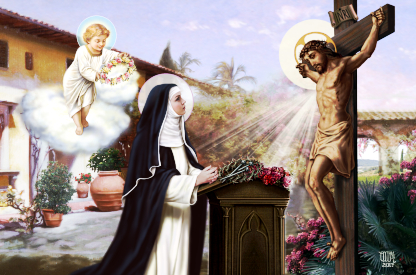Lives of the Saints
Our Models and Protectors
Spiritual Bouquet:
August 30

O.D.M. pinxit
Saint Rose of Lima
Virgin
(1586-1617)
This lovely flower of sanctity, the first canonized Saint of the New World, was born at Lima, Peru, in 1586. She was christened Isabel, but the beauty of her infant face earned for her the title of Rose, which she thereafter bore. As a child still in the cradle, her silence during a painful surgical operation seemed to foretell the thirst for suffering which would consume her heart.
At an early age she engaged herself as a servant to support her impoverished parents, then worked day and night. In spite of hardships and austerities her beauty ripened with increasing age, and she was openly much admired. Fearing vanity would enter her heart, she cut off her hair, blistered her face with pepper and her hands with lime. She never left the interior of her parents' house in Canta, for four years, not even to walk in an inviting garden just beyond its walls. She finally obtained her parents' permission to be enrolled in the Third Order of Saint Dominic; from her childhood she had taken Saint Catherine of Siena as her model, and she then redoubled her penance. The Blessed Sacrament seemed virtually her only food. Her love for it was intense. Her fasting was near miraculous; during Lent in particular, she denied herself her former single piece of bread each day, to consume only a few orange seeds. Her disciplines were of an almost incredible severity, and her hair shirt reached from her shoulders to her wrists and knees; not satisfied with its rudeness, she armed it with iron nails.
The cell of Saint Rose was a garden hut, her couch a box of broken tiles. Concealed by her veil, a silver crown armed with ninety sharp points encircled her head. More than once, when she shuddered at the prospect of a night of torture, a voice said, My cross was yet more painful. The demon tormented her for fifteen years with insupportable temptations; but God sustained His spouse against them, though she would gladly have died rather than live any longer in their clutches. When a Dutch fleet prepared to attack the city of Lima, Rose took her place before the tabernacle, and wept because she felt unworthy to die in its defense, as she hoped she might; the enemy weighed anchor soon afterwards and departed without attempting a siege. All of Saint Rose's sufferings were offered for the conversion of sinners, and the thought of the multitudes in hell was ever before her soul. She died in 1617, at the age of thirty-one.
Reflection: Rose, pure as driven snow, was filled with deepest contrition and humility, and did constant and terrible penance. Our sins are continual, our repentance passing, our contrition slight, our penance nothing. How will it fare with us?
Little Pictorial Lives of the Saints, a compilation based on Butler's Lives of the Saints and other sources by John Gilmary Shea (Benziger Brothers: New York, 1894).